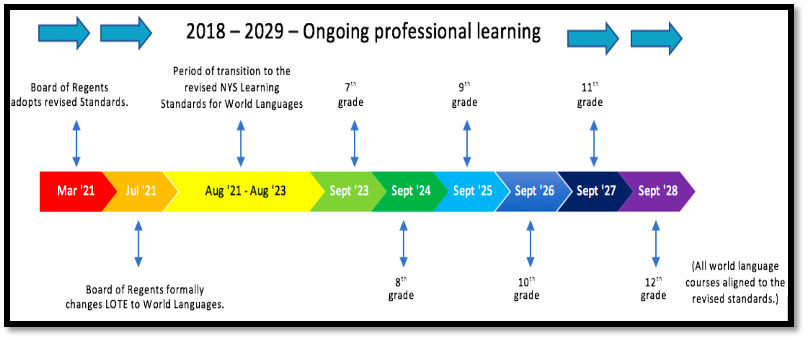Fact Sheet 22-06. April 2022.
Name Change to World Language
World Languages (WL), formerly known as Languages Other than English (LOTE), was officially adopted by the NYS Board of Regents in July 2021. This name change will amend Commissioner’s regulations in all references to the term “Foreign Languages” to now read “World Languages” in the learning standards, pathway assessment, course credit, teaching certificate titles, certification, and teacher preparation program coursework requirements.
To implement the name change, teachers currently in the Foreign Languages tenure area will now be in the World Languages tenure area and any prior service will be included in the renamed tenure area.
NYS Learning Standards for World Languages are divided into two language groups: Modern Languages and Classical Languages. These revised standards for both are organized into two anchor standards: Communication and Cultures. (See Appendix A for a breakdown of the anchor standards). The revised standards are aligned to the national World-Readiness Standards for Learning Languages, developed by the American Council on the Teaching of Foreign Languages (ACTFL), and represent what students should know and be able to do in the languages and cultures which they study. The key shifts to the revised standards include:
- updated curricular topics organized under four over-arching themes
- benchmarked performance indicators with target ranges for each Checkpoint
- instruction in the target language for the culture standard
Unlike the standards of other disciplines, the revised standards are not grade-banded, but instead grouped into three proficiency ranges that correspond to the World Language Checkpoints (A, B, C) and reflect the levels of achievement students must reach generally over the course of two years of study for each Checkpoint.

NYSED has created a crosswalk between the 2021 revised Learning Standards for World Languages and the 1996 Learning Standards for LOTE. This crosswalk is available as Appendix A to this Fact Sheet. The implementation plan includes four critical components: Standards, Professional Learning to Enhance Instruction (Curriculum, Assessment, and Instruction), Materials and Resource Support, and Administrative and Community Support.
The phase-in timeline encompasses ongoing professional learning and a gradual roll out by grade level with all WL courses aligned to the revised standards by 2029.
District-Level Protocols for a Successful Standards Implementation
While the timeline in place is beneficial, actions taken by the district and decisions made by the WL department are crucial for a successful implementation.
Curriculum Development Support: Adjusting the curriculum to align it to the revised standards should be part of paid districtwide curricular writing projects. Teachers must be provided the opportunity to attend high quality training devoted to collaborative standards implementation across the WL department.
Articulation Meetings: Under the backward-design model, teachers of all levels will be revising curriculum. As a result, teachers from all levels of instruction will need common time to establish vertical alignment between courses and across levels simultaneously and together.
Professional Learning: Districts are required to organize and provide timely, relevant professional learning opportunities at the district’s expense during the contractual day and provide proof of attendance for CTLE hours. Teachers should be compensated for professional learning outside of the contractual day. Such opportunities need to be responsive to stakeholders’ needs and concerns.
Attendance at Training: Teachers should be encouraged to seek out a variety of training opportunities and multiple modes of delivery from providers including NYSED’s Office of Bilingual Education and World Languages (OBEWL), New York State Association for Language Teachers (NYSAFLT), NYSUT Education & Learning Trust (ELT), and other recognized World Language professional organizations. District support for these opportunities may include release time, registration fees, transportation reimbursement, substitute costs, materials, etc.
Supporting Strong World Languages Programs
Adequate Staffing: Proactive recruiting, hiring, and planning to avoid attrition are essential to continuing strong programs in multiple world languages. Teacher workloads should be reasonable according to contract language, and the number of preparations kept to a minimum.
Class Size: The revised standards require the assessment and feedback of student interpersonal communication. Smaller class sizes are ideal in that they allow for sufficient time to monitor each student’s continual progress while documenting language proficiency growth.
Resources: Access to authentic resources (i.e., video hosting websites, subscription services, and websites from world countries) are considered instructional materials and must be made available for teachers and students in WL classrooms. Districts should be responsive to stakeholder input as well as provide access and funding for up-to-date resources aligned with the revised standards.
Instructional shifts: Administrators should encourage and support teachers to expand their instructional practice through new approaches in their efforts to implement the revised standards.
Advice for Local Leaders
Union leaders have an influential role in being the voice of members and making positive changes happen through advocacy.
- Ensure that all district stakeholders are aware of the standards, certification pathway and tenure name change, including teachers, counselors, administrators, Human Resources, Board of Education members, staff, and community members.
- Support the education of administrators on best practices for WL instruction and in understanding the revised standards to effectively support and observe WL teachers.
- Hold the district accountable for adhering to the number of different preparations, workload, and class size that follow the negotiated contract.
- Monitor the district to ensure compliance with the required WL units of study per C.R. Part 100.2.
Resources
SL/mc 4/22
Comparison Charts
For NYSED charts comparing NYS Learning Standards of 1996 to 2021, please download the PDF version.